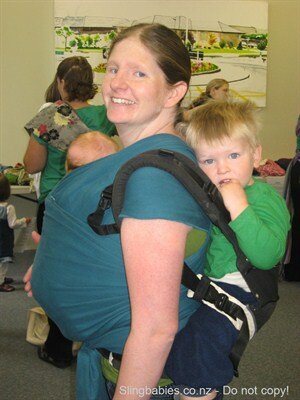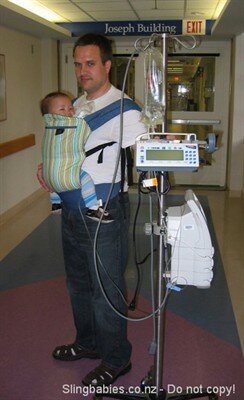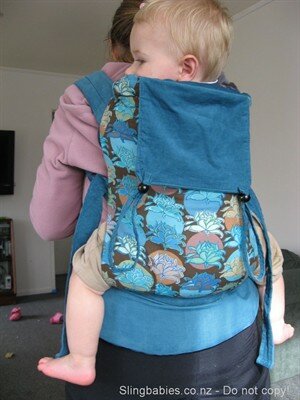The Benefits of Babywearing

Clever Rachael wears her children so she can get on with her day and meet their needs at the same time!
- Sling-babies are documented to cry up to 50% less on average than non-carried babies. In western countries, we are told that 'up to 2 hours per day of crying is normal'. Errr no. This is a leftover of old-style parenting methods involving making babies do as you want, not following their lead and gently guiding them. Babies cry for a reason. In countries where babies are worn in slings, their babies rarely cry because their needs are already met. When our baby is relaxed and happy, so can we be, which makes the adjustment to new parenting a whole lot easier.
- They are calmer, and spend more time in a state of 'quiet alertness' According to Dr Sears, Slingbabies use their valuable energy for learning about their world, so they don't need to fuss as much. Instead of being put in a rocker or other contraption, forced to watch the world but not be a part of it, sling babies get to passively participate in their world. They get to do what mum does, and see what mum sees, from the safety and comfort of their little nest. They can choose to retreat back when it gets a bit much, or look out if they want. They are able to select what they want to look at, and not become overstimulated.
- Babies' biological need for body contact and motion is met. Ever noticed the 'mummy dance'? You know the one. Babies love motion, their brains benefit from it, as well as their bodies. Being worn in a sling is great non-contact 'exercise' for babies. Kangaroo Care (baby skin-to-skin on mum's bare chest) is extremely beneficial for wee premmie babies, it has been proven very helpful for their development and survival chances. Babywearing helps babies get over the initial 'shock' of being born into this loud bright cold world. A sling recreates the womb environment, which is extremely comforting for baby. They can hear mum's heartbeat, feel mum's warmth, and move with mum's body- just as they used to in the womb. Skin to skin contact helps with breastfeeding
- Slings are a great parenting tool. You can have baby quiet and content, and still do your chores/shopping etc. This means parents don't need to be scared of baby having a meltdown at the mall- they're happy in their sling already. This means parents can relax and enjoy their outings, knowing their baby will be content. Baby carriers are a great solution to the 'arsenic hour' You can cook and keep baby happy simultaneously. No more rushed dinners, takeaways or grumpy afternoons. You need no longer dread 4pm!
- They have better digestion from the gentle tummy pressure. Notice how reflux and colicky babies love to be upright? It makes sure that the milk and stomach acid stays down where it should, and helps trapped gas come up. Happy baby, happy parents!
- Your baby is just happy to BE with you- as opposed to being left to play with unnecessary expensive toys. They often become more independent later on than non-carried babies, because they are so secure and confident. Wearing baby close in a sling helps mums and dads to bond with their little ones. It takes the pressure off parents to actively entertain their babies, baby is quite happy doing your activities with you.
- Sling-babies can nap anywhere- at the soccer game, the mall, social occasions. Sling babies are super-convenient: no need to worry about access for the pram, or somewhere for baby to sleep when you're on holiday. Slings just take that stress away.
- Baby carriers are great for baby's developing hip joints. Because baby is (ideally) in the correct 'frog' position - hips flexed and abducted- it encourages proper development of the head of the femur into the hip socket. This is the same position 'hip babies' are put into, to help their hips correct.
- Breastfeeding is convenient and private in a baby carrier. You have your own private feeding room right with you. Plus, mum can recognise and respond to baby's hunger cues earlier which means less fussing. With baby close, they tend to like feeding more often, which is good for mum's milk supply.
- Wearing your baby burns up to around 300 extra calories a day! A brisk ten minute walk will lose you 100 calories. Baby provides as much 'resistance' (or more) as a pair of handweights. So pop that baby on and go for a walk, you will both benefit.

Mirazilla - Dad with Beco carrier in hospital
One Mother's Perspective: Reasons I love Babywearing...
by Jennifer Rosenberg, in 'Babywearing' by Dr Maria Blois
Babywearing is not dependent on:
- Where or how you birthed your baby.
- How you feed your baby.
- Where your baby sleeps.
- Whether you are the child's biological parent
- How you choose to diaper.
- Most medical choices parents make
For baby, Babywearing:
- Helps at-risk babies learn how to be in the world in a gentle, loving way.
- Helps babies who have had separations from parents recover their bond from that.
- Helps adopted babies learn to be comforted by a different rhythm.
- Helps high-need babies learn to integrate the world.
- Helps meet all babies' need for early dependence which allows them to be more independent as they get older.
For parents, Babywearing:
- Facilitates attachment parenting for parents who were not parented that way.
- Allows parents to meet a baby's need to be held and their own need to do other tasks.
- Reduces the impact of a high-need baby on daily living for other family members.
- Changes the way parents view a baby's needs.
- Puts parents in closer contact with baby which usually makes it easier to "read" baby.
- Provides a buffer against separations ranging from daily work or separate sleeping, to hospitilization.
- Can facilitate breastfeeding and make it easier to breastfeed longer.
Babywearing can begin at birth, in toddlerhood, or even the preschool years. It has benefits at all ages when a child wants or needs to be held. It can extend the ability of a parent to carry a child beyond the 'in-arms' stage. And it does not rely on politics, religion, or even any specific parenting philosophy to confer its benefits.
(Used with permission from Jennifer Rosenberg)

One homemade soft carrier = hours of handsfree parenting fun!
A sling can make your parenting job so much easier!
For me personally, my sling was the difference between coping with two kids, and not. When you have a toddler or two (or three), just because you have a new baby doesn't mean you aren't needed any more, or that you get time to rest. In reality, you don't. Life goes on, and the laundry needs doing, kids need taking to kindy, the dog needs walking. My sling was my lifesaver in that way.
Of course, babies who aren't worn in slings will turn out just fine, and most are loved and cherished and held.
But those lucky babies who are 'babyworn' for a decent portion of the day enjoy large benefits. Dr Sears, who invented the terms 'attachment parenting' and 'babywearing' says that while they are being worn, babies 'soak up the world around them'. They absorb many subtleties we miss, the beat of our hearts,the smell of us, the eye contact of friends, the body language of people we interact with. They do so much learning from being immersed in daily activity yet have that vital advantage of retreating when theyneed to. A really important benefit of babywearing Dr Sears mentionsis the development of the brain from being exposed to environmentalstimuli. Instead of being scared by new noises or experiences, babyfeels safe on mum and is able to learn from them. They are able to observe many patterns of behaviour from people around them, which are stored away for later learning. Read here for more of what Dr Sears says about babywearing benefits .
Internationally renowned Lactation Consultant and Anthropologist Diane Wiessenger (M.Sci, ILBLC) firmly believes in babywearing as part of a responsive parenting relationship. See her 'Wearing your Baby' page for more information, or her website for great parenting information. .
What is attachment parenting?
Babywearing is a part of a gentle parenting concept called 'Attachment parenting '. There are no set 'rules', just guiding ideas.
But although babywearing is a very important part, it does not meant that you must practice this method of parenting if you want to use a baby sling.
As with anything, you just take what you like from it, and leave what doesn't suit your family. This is the beauty of it: ANYONE from any background, can be a baby wearer. It doesn't matter if you bedshare or not, breastfeed or not, or even if you're the Grandma or Uncle. Anyone can do it if they choose.
Attachment to your baby means feeling connected and bonded. Babywearing helps this by keeping baby close to you, which encourages the production of mothering hormones, which in turn assist breastfeeding and bonding.
Following AP does not mean being a pushover parent, doing what ever your child wants and not laying down any family rules at all. This is a common misconception, but is not common sense. Dr Sears says "The better you know your child, the more your child trusts you, and the more effective your discipline will be. You will find it easier to discipline your child and your child will be easier to discipline."
Another way I like to think of AP is 'intuitive' or 'responsive' parenting.
It really is common sense: interpret and respond to your baby's cues appropriately and with love. That is all a baby wants. And responding to their cues teaches them that communicating with you works, so they continue to do it. If a baby's cries are ignored, all it teaches them is not to bother trying to communicate, there is no point. They may withdraw and begin to 'shut down ', which is sad and so unnecessary! Read what Dr William Sears says about Shutdown Syndrome
The old-school theory that picking up babies and wearing them spoils them, has been disproved.
Babies who are have their need for loving physical contact met are shown to end up more secure and confident than those who have less touch/ contact/ interaction in their first year.
"When a baby is touched with warmth and care, the brain is flooded with hormones. These enable the child to form the brain connections he or she will need to develop feelings of warmth, love and empathy towards others." Brainwave Trust PDF 'The First Three Years Last Forever' Click to download
However, the 'spoiling' theory hangs around and is pushed by many 'expert' sources who should know better. Mums and Dads are still encouraged to ignore their instincts, and follow prescribed 'baby training' methods, ignoring their baby's communication. Then they become worried when their baby doesn't respond positively to the 'rules'. Whose rules? Someone else's rules, from someone who doesn't even know their baby personally.
Our babies are all different, they have not read the same books as us, they only know that they need us here and now. Let's be available physically and emotionally to our babies. Not pushover-parents, but responsive, firm and loving.
See the Centre for Attachment website for more information on Attachment Parenting in NZ
Diane Levy talks about Attachment Parenting on the Kiwi Families Website.
Excerpts from Dr Nils Bergman's paper on 'Restoring the Original Paradigm for Infant Care ' talking about the importance of Kangaroo Mother Care for premature babies.
Some may feel that the human being with its massive forebrain cannot be compared to other animals. There has however been anthropological research which further supports this view. Homo sapiens evolved as "tropical hunter gatherers" over the last 3 million years.
Changes started 10000 years ago with the beginning of agriculture, but there are still tropical hunter gatherer peoples living, which have been studied by anthropologists. Common for all groups is that newborns and infants are carried constantly, they sleep with their mothers, there is immediate nurturant response to crying, feeding takes place every 1 or 2 hours, and breastfeeding continues for two years.
In the last 100 years, this million year pattern (of “carry care:”) has been changed to one where the child is left lying still (“cache care”) separated from mother, ignored when crying, fed four hourly by the clock (“nest care”), with formula (from a “follow care” species) and substitutes from an early age.
Lozoff et al (1977) state that these changes altar the initiation of the mother-infant relationship, which may be "strained beyond the limits of adaptability". "Separation causes changes in the fundamental efficiency of systems". "Early separation can produce major shifts in susceptibility to stress-induced pathology". "The origins of many behavioural deviations are unknown ... can some be traced back to violations of an innate agenda?"
"...................The primary violation, the worst case scenario, to any newborn is separation from its habitat/mother. This applies to Homo sapiens as fully as to other mammals studied........................." The KMC paradigm holds that prematurity is not a disease, but that separation from the habitat (mother) will make a premature diseased. Likewise withholding of the niche (breastfeeding and breast milk as two separate concepts) will make the premature diseased. In the KMC paradigm the original habitat and niche is the starting point of care, to which we add whatever available technology and support is available.
|